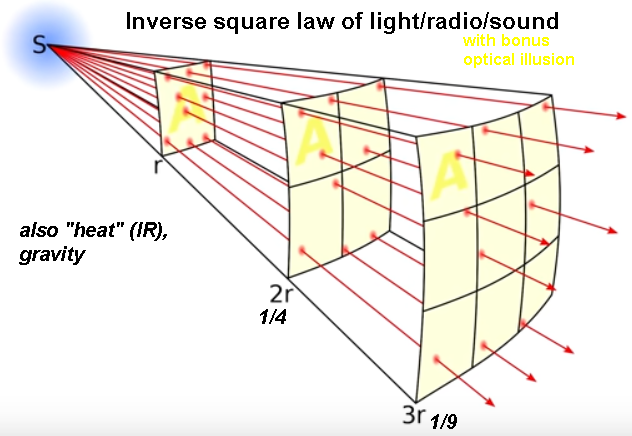

Omindirectional vs directional narrowbeam antenna.
dish and parabolic grid and Yagi are directional (must be aligned), others are omnidirectional:

Omnidirectional antenna's energy pattern:


Directional antenna's energy pattern: more focused

Gain is a measure of directionality, in dBi. E.g. parabolic are high gain, dipole
is low gain (1.76dBi).
5dBi gain of WAP external antennae.
Antenna shape is passive gain. Increasing signal strength (amplification) is active gain.
WAP and some WNICs can control signal strength.
The higher the frequency the more it can be focused.
Radio propagation is complex:
sporadic and usually temporary losses due to fading, shadowing, hand off.
Interference from overlapping channels, other machines (Bluetooth, cordless phones, microwave ovens,
baby monitors, motion detectors, fluorescent lighting, RFID reader, radar, drones etc.).
RSSI is strength of received energy.
SNR (signal-to-noise ratio) is how much of that energy is signal.
SNR degraded by atmospheric attenuation and beam divergence.
SNR more important than RSSI: noise floor dependent.
Free Space Path Loss: weakening of the signal as it spreads out in 3D; the energy is being dispersed.
Diffraction (bending around corners), reflection, refraction (thru), scattering,
absorption (penetration loss) in walls (heating the material) all cause problems.
Multipath interference (ghosting, fading) due to relections. Compensated by
diversity eg. multiple receiving antennas.
Frame preamble received by both antennas, then the rest of the frame by the better receiving one.
Multipath rarely affects both antennas simultaneously.
820.11n MIMO up to 8 antennas but 3 is most common.
External antenna of a WNIC card can be better range than the built-in antenna of laptop.

EIRP (effective isotropic radiated power) = transmitter+ andtenna gain - cable loss,
in watts per meter squared. Efficiency with which transmitter
delivers power to remote receiving antenna.
Antenna should be several times larger than wavelength.
International and US spectrum regulated by ITU and FCC.
Radio link assigned a frequency band, radiation pattern, max power.




2.4GHz vs. 5GHz: longer wavelength → greater range, more congestion from neighboring networks,
3 non-overlaaping channels vs 24, more interference from other non-WiFi devices,








Bluetooth
2.4GHz, cable replacement, piconet, 802.15 wireless PAN.
low power, short range, low rate.
2.4 - 2.835 GHz: 79 channels @74MHz, each containing separate frequencies for 1 and 0.
FHSS (frequency hopping spread spectrum) 1600 hops/s.
The two ends agree on the schedule of channels.
One half duplex packet per 625 us time slot.
Noisy channels skipped.
packet: Preamble, 72-bit Access codes (address), 54-bit Header (size), 136-8168 bits data payload
NACKs?
WiMax / WirelessMAN 802.16
alternative to cable and DSL for last mile broadband access.
various licensed spectrum.
BLE (Bluetooth Low Energy): 1/2 mile range. Mesh network of devices.
NFC (Near field communication): smartphone payment. access token.
ANT: low power. Fitness devices.
Z-WAVE: home automation devices. Mesh of them.
Zigbee: low-power, low data rate, and close proximity (personal area) wireless ad hoc network.
IR: control TV.
RFID: tracking. Powered by reader, sends its ID.
UHF 300MHz-3GHz 1m-10cm.
microwave line-of-sight point-to-point links
(1.7-2.3GHz?) (building to building or city to city).
run at 100Mbps ethernet
Microwave, Fiber, ISDN links in a CAN/MAN/WAN
Laser, Microwave, Fiber links in a CAN/MAN/WAN
SHF 3GHz-30GHz 10cm-1cm.
GEO satellites (uplink/downlink,
transponders (155Mbps), w/signal propagation delay of 250 ms, Intenet access (1,
4, 16Mbps) simplex download w/POTS upload), rain fade.
Starlink constellation of 1000-10000 LEO satellites (latency 20-40ms). Dishy "user terminal": phased array antenna (flat, many small antenna elements beamform (aim/steer)), up to 1Gbps, runs Linux, 100W POE
Cellular telephone...
1G analog. 2Kbps data
2G: GSM and CDMA voice-only. 9-200Kbps
3G WCDMA 384Kbps? 2Mbps
4G LTE 20-100Mbps
LTE+, LTE-Advanced ("5G"=LTE+carrier aggregation) sub-6GHz, 300Mbps ?1Gbps. 4 MIMO antennas.
Booster uses just one antenna, can improve upload but decrease download.
6G: mmWave=20-300 GHz, Massive MIMO, carrier aggregation, beamforming (location to within inches),
but needs LTE also because of mmWave weakness.
cell phone: IMIE burned-in, and IMSI (SIM card, =phone#). Both globally-unique.
cell site (cell tower) -- back haul (fiber) -- core network
GPS: constellation of 24-31 satellites. Each sends its location and atomic-clock time.
3 could pinpoint your GPS receiver's location on Earth if its clock were good,
but it isn't, so a 4th is needed to solve its time offset.
Special Relativistic slowdown of atomic clock 7 us/day because is moving 14000km/hr.
General Relativistic speedup of atomic clock of 45 us/day because it is 26000km
from Earth's center thus weaker gravity. Net is +38us/day, adjusts the atomoic clock.
Light: 1us = 300m
1.57542 GHz (L1 signal) and 1.2276 GHz (L2 signal)
L5 band 1.17645 GHz: accuracy to 30cm